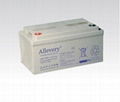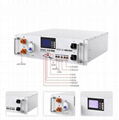Product Description
Features and application of lead-acid batteries:
No maintenance: over the lifetime of the battery without adding water rehydration.
High reliability, long life, special sealing structure and flame retardant case, not in the course of electrolyte leakage defect will not fire.
Weight, volume and high specific energy, internal resistance, high output power.
Self-discharge, 20 ℃ under the monthly self-discharge rate is not more than 2%.
Man charged the factory, no flow of electrolyte, transport safety.
Wide temperature range: Standard Series Battery (-30 ℃ ~ 50 ℃), high temperature range (-45 ℃ ~ 70 ℃)
No balance charging, due to the internal resistance of single cells, capacity, consistency of quality float voltage to ensure that the battery during use, without a balanced charge.
Recovery performance: the battery had discharged to 0 volts, short circuit for 30 days, can still charge to restore its capacity.
Solid copper terminals: ease of installation and connection, conductive ability.
Computer-aided design and computer control of major production process to ensure consistency of product performance and meet design standards
Use of solar photovoltaic system, street and city lighting engineering, wind power energy storage, wind and solar lights, garden lights, beacon lights, lights, power plants, substations, telecommunications, telecommunications, electricity, nuclear power, hydropower, UPS uninterruptible power supply, EPS Emergency Power Supply, microwave relay stations, standby power, all the DC power supply, AC to DC inverter systems, railway rolling stock, electric cars, ships, electric boats, electric boats, switches, emergency lighting, coal mine explosion-proof traction, battery car, truck, car starting, lighting, fire, alarm, medical, telemetry equipment, security systems, portable power, portable electrical appliances, pump systems, scales, etc.
Note: The above can produce different specifications according to customer requirements to support our efforts with what Oh
Standard series design life of LFP Model FP model -5 -10 -18 models of long-life CFP 12 years OPZV / OPZS series of more than 20 years
4. Installation
(1) Check the battery before using the appearance of
(2) The battery must be installed by professionals to carry out.
(3) batteries can not be confined or high temperature environments (temperature recommended recycling -5 ~ 35 ℃.)
(4) handling the battery should be installed even by force, force at the shell should be part of the battery to avoid damage the pole.
(5) The only parallel in a multi-use batteries, press the battery polarity "+","-" identified in order of priority, not less than the distance between the battery-15mm.
(6) in the cell connection process, wear protective gloves, use the torque wrench and other metal tools, metal tools, please insulation packaging, absolutely avoid contact with metal tools at the same time to the battery positive and negative terminals.
(7) If you need to use batteries in parallel, generally not more than three (only) in parallel.
(8) and the external device before the device is disconnected, and then the battery (group), the positive cathode connected devices, battery (group) the negative extreme negative connected device, and fastening a good cable.
5. Notes
(1) non-professionals can not open the battery, so as to avoid danger, such as accidentally rupture the battery shell, exposed to sulfuric acid, rinse with plenty of water, if necessary, call a physician.
(2) the use of multiple batteries, pay attention to the connection between the battery is correct, be careful not to short circuit.
(3) the use of the process should avoid strong vibration or mechanical damage
(4) the use of upper and lower battery container with a vent for cooling.
(5) Do not let the rain poured into the battery, or immerse in water.
(6) cleaning the battery as possible, please use the wet cloth to wring, do not use a dry cloth or duster, etc. Do not use chemical cleaning agent to clean the battery.
(7) Do not mix different capacity with boxes, old and new, different battery manufacturers.
2. General characteristics
2.1 Discharge
2.1.1 discharge termination voltage:
To ensure the safety and maximum battery life, battery discharge termination voltage and the size of the battery discharge current, discharge current, battery voltage can be lower end, whereas the discharge current, battery termination voltage is higher. (Table 1) at different power rates recommended discharge termination voltage.
Discharge current discharge termination voltage: (VPC)
Less than 0.1CA 1.75
0.11-0.17CA 1.70
0.18-0.25CA 1.67
0.26-1CA 1.60
Than 1.1CA 1.30
2.1.2 Discharge capacity:
Battery discharge and the discharge capacity of the main current and ambient temperature
Battery capacity and discharge current relationship:
(Figure 1,2,3) for the FP, LFP, CFP model battery discharge rates at different conditions, the capacity of the release, can be seen from the figure, the greater the discharge rate, the smaller the capacity of the battery can discharge.
2.1.3 Battery Capacity and Environmental Temperature:
In the discharge current constant, high temperature, the battery discharge capacity and more, on the contrary, the ambient temperature is low, the battery discharge capacity less (figure IV) relationship for the battery capacity and temperature curves.
2.2 Charging
2.2.1 Charge Method
Charging method, It is important for the battery, incorrect battery charging method will charge or charge less, affect battery performance and life.
Common charge following two methods.
A, constant current limiting charge
B, constant current charging
Constant charge current limit:
Of VRLA batteries, the VRLA battery charging method is the best charging method. Control the charging voltage and ambient temperature and battery the way.
Spare battery: 2.23 ~ 2.30 / single cell, at 25 ℃,
Cycle with battery: 2.40 ~ 2.50 / single cell, at 25 ℃.
Note: Maximum charging current is generally set at the beginning not more than 0.3CA,
Figure 5-6 for the battery charging curve, can be seen from the figure, at 25 ℃ when the battery charge voltage of 2.30V / single cell, the battery is fully charged, the charge current reduced to 0.5 ~ 4mA/AH, remain change.
When the battery is 2.4V / single cell, the battery is fully charged, the charge current reduced to 3 ~ 10MA/AH, remain unchanged.
Constant current charge:
The method used to charge the battery, note the battery is fully charged rechargeable power supply must be immediately cut off, otherwise it will overcharge the battery, and damage to the battery performance and life, using constant current charging, the charging current is generally not more than 0.1CA, when the charge The last time the battery discharges electricity to the amount of 1.07 ~ 1.15 times that of the battery is fully charged.
2.2.2 Temperature effects on the battery charge voltage:
Because of chemical reactions accelerated by increasing temperature, the decrease of temperature slows down.
In order to prevent over charge or under charge the battery when the battery temperature is not 15 ℃ ~ 35 ℃, the need to adjust the battery charging voltage.
Adjustment method is:
At 25 ℃ as the reference, voltage adjustment coefficient: ± 3MV / ℃ single-cell l (battery backup); ± 4MV / ℃ single-cell l (cycle battery),
For example: use of a UPS battery backup 8 12V65AH to do in summer when the battery room temperature is 40 ℃, the charging voltage from 8 × 6 × 2.30 = 110.40 should be reduced to:
8 * 6 * [2.30-3 (40-25) / 1000] = 108.24V
Room temperature in winter when the battery dropped to 10 ℃, the charge voltage should be increased to 110.40V:
8 * 6 * [2.30 +3 (25-10) / 1000] = 112.56V (Figure VII) to charge the battery voltage and temperature relationship curve.
2.2.3 Charging time:
In terms of battery backup when the battery-powered, the battery needs recharging time, generally not less than 24H. In terms of recycling used batteries, if you know the last time the initial discharge capacity and charge current can be calculated by the following formula is 25 ℃ ambient temperature required charging time.
A, when the discharge current is greater than 0.25CA when
Tch = Cdis / I + 3 ~ 5
B, when the discharge current is less than 0.25CA when
Tch = Cdis / I + 6 ~ 10
Note: Tch battery charging time required for full power (H)
Cdis a discharge on the battery power (AH)
Maximum initial charging current I (A)











